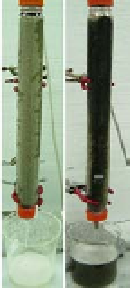Environmental Engineering Reference
In-Depth Information
arsenic free water (Kanel et al., 2007b). Figure 11.14 shows a typical experimental set
up and the breakthrough curve; the S-INPs are much mobile than the as-grown INPs.
It is important to note that one-dimensional transport studies cannot represent
more complex transport scenarios occurring in multi-dimensional groundwater aquifers.
Recently, Kanel et al., (2007) investigated the transport properties of polyarylic acid
stabilized INP (S-INP) through porous media in a two-dimensional physical model that
was constructed under saturated, steady-state flow conditions. Transport data for INP, S-
INP, and a non-reactive tracer were collected under the similar flow conditions. The
results show that un-stabilized INP cannot travel in a long distance in the groundwater
aquifer, while the S-INPs can travel like a tracer without any significant retardation.
However, the S-INP plume migrates (vertically) downwards as it transits horizontally in
the physical model, indicating that the density of the S-INPs would affect the transport
of S-INPs (Kanel et al., 2007a). Nevertheless, S-INPs have great potential to stabilize a
variety of contaminants under in-situ conditions. More basic and fundamental studies are
needed for the application of these promising INPs for in-situ groundwater remediation.
1.0
a
a
a
b
b
b
0.9
0.8
0.7
0.6
0.5
0.4
0.3
0.2
0.1
0.0
0
20
40
60
80
100
120
140
Time (days)
Figure 11.14
Breakthrough curves of As(III) (500 μg/L) passed through S-INP (12 g)
anchored sand (425-600 μm) packed columns at a flow rate of 1.8 ml/min in upward
direction. Inset shows comparison of effluents collected (a) without and (b) with S-
INPs. The arrow in (a) shows INP stuck at the top (Kanel et al., 2007b).



















































































Search WWH ::

Custom Search